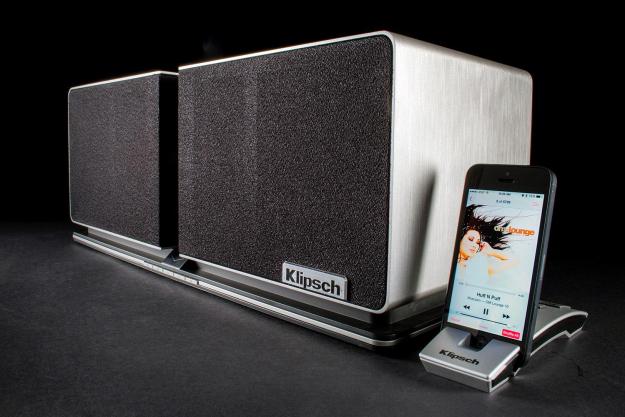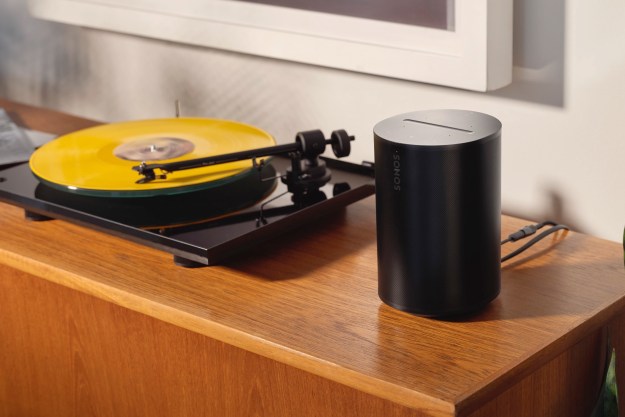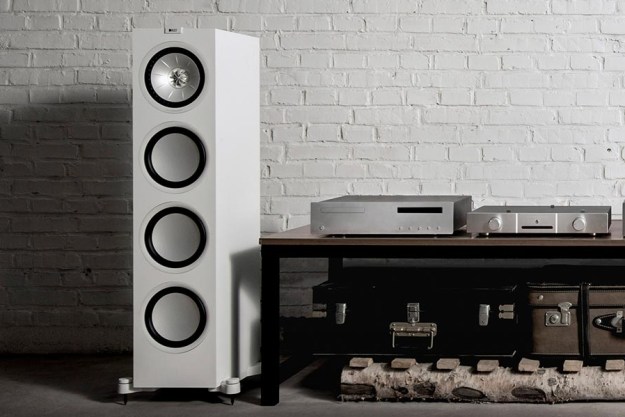
“Klipsch’s Stadium is a single-box solution with none of the trappings of a more conventional rig. It’s an absolute knockout, and people are going to love it.”
- Massive, clean sound
- Deep, tight, tuneful bass
- Simple setup and use
- Gorgeous aesthetic
- Remote has a cheap feel
- Bass may be too much for smaller environments
What happens when one of America’s oldest loudspeaker companies crams 68 years of design and audio engineering experience into a built-to-the-hilt, state-of-the-art tabletop speaker system? The Klipsch Stadium.
The Stadium is a luxury item through and through, and it’s got the price tag to match; you’ll need to pony up $2,000 to get your hands on one. But if ever there was a luxury item that earned its asking price, it is the Stadium. Underneath the Stadium’s minimalist, brushed aluminum exterior resides an acoustic megaton of audio tech that Klipsch claims will deliver an experience on par with what you’d expect from a full-size sound system.
We’ve been watching the Stadium take shape over the past couple years, and we’re excited to be among the first to give it a thorough test run. Here’s what living with the Stadium for the past month has been like.
Hands on video
Out of the box
The Stadium’s heft will shock you. On paper, 28.5 lbs. may not seem like a lot, but when packed into an 8.25 x 21 x 8.5 (H x W x D – in inches) enclosure, it has a way of feeling a lot like a sack of bricks. We’re not complaining, though. We’ll take the highly rigid cast aluminum enclosure and robust motor structure on the system’s subwoofers any day.
Underneath the Stadium’s minimalist … exterior resides an acoustic megaton of audio tech
Prying open the Stadium’s box revealed a dense EPE foam cap with cutouts for various accessories, including a funky horn-shaped tablet stand, an antenna, power cord, and a remote control, all shrouded in black cloth sacks. A quick-start guide, warranty card and safety instructions were also included – no mention of hernia avoidance measures.
Once we had the stadium pulled from its box and removed from its own black sack, we took a moment to appreciate the speaker’s finish and general appearance. The big block of aluminum is mega-manly in a way that huge hunks of metal tend to be, but there’s also something sophisticated about the Stadium’s radius edges and slim platform that kept it looking right at home in some of our modernly-designed office spaces. Sitting on an entertainment cabinet in our home, the Stadium looked in command of the room, ready to juice up the space with robust sound when given the sign. We decided we liked the system’s looks better with the magnetic speaker grills removed, but we’ll admit the Stadium looks a little less speaker-ish with them in place.
Features and design
Though AirPlay seems to be taking a backseat to Bluetooth as the wireless audio protocol of choice these days, Klipsch included both options in the Stadium, and we think that was a smart move. Though the Stadium is also DLNA compliant, allowing various network streaming options, AirPlay is arguably the easiest way for Apple and iOS users to get their music from their computers to a network speaker.

Of course, the Stadium is ready for hard-wired connections from your TV, Blu-ray player, and other devices, too. Along the back of the unit we found a digital optical (Toslink) connection, a set of stereo RCA inputs, and a USB port for direct digital connection and charging of iOS devices.
For those readers not all that interested in the Stadium’s rather involved innards, here’s what you need to know: The Stadium has more power than you need, and the drivers built into it are state of the art. Whether you’re looking for bragging rights, or a reason to do your best Tim the “Toolman” Taylor-style gorilla grunts, owning the Stadium will give them to you; guaranteed. You may now feel free to move on to the performance section.
… it’s very likely that you’ve never heard anything quite like it before.
All of those drivers are powered by a fully digital amplification system capable of delivering 400 watts peak power. Crossovers are completely electronic, so you can think of the Stadium as a sort of active speaker system – not entirely unlike, say, Genelec’s well-reputed designs.
Except the Stadium is a fully self-contained system with a remote control to switch among inputs, integrated volume control and the ability to play music from wireless devices. It promises to be the most badass one-box audio solution in the land. So, is it?
Setup
One of the great things about the Stadium is that there really isn’t much to set up to begin with. Connecting via Bluetooth is as simple as pressing a button on the back of the unit to prompt it to connect, then finding it in your device’s Bluetooth settings. Once paired, you’re good to go. Airplay is only slightly more involved. You’ll want to download the Klipsch Air app and select setup from the menu at the bottom of the screen. From there, select the Stadium speaker and follow the instructions. You’ll wind up connecting your iOS device to the stadium with an iOS charging cable and letting the Stadium access your network settings. From then on, the Stadium will appear as an Airplay speaker on your network.
The Klipsch Air app also provides a very basic EQ, which allows for adjustment of bass, midrange and treble frequencies. The EQ is pretty gentle, so don’t expect wide swings of adjustment. You won’t need to make any dramatic adjustments, anyway.
Performance
We face a certain kind of challenge in attempting to describe the Klipsch Stadium’s performance. You see, nothing quite like it has ever been built before, and it’s very likely that you’ve never heard anything quite like it before. Without a frame of reference, it can be hard to imagine what the Stadium does, but we’re going to try to help you to anyway.
Imagine taking a pair of high-end bookshelf speakers and placing them about 1.5-feet apart, then mating them to a high-quality 10 or even 12-inch subwoofer, and driving the system with a high-current integrated amplifier which just so happened to have digital inputs, bass management and two flavors of wireless streaming ability. Now, imagine putting on your favorite music or movie and cranking it up – loud folks, seriously – and hearing little to no distortion.

Finally, imagine that, to get this sound, you didn’t have to run speaker wires anywhere, let alone figure out where to hide them. Imagine not needing to find the right place to put your subwoofer, run power to it, or run a long subwoofer cable to it. All you do is turn the system on and press play on your smartphone, Blu-ray player, CD player … whatever. And anyone visiting your home could figure out how to use it in a minute or so.
That’s kind of what it’s like.
Real Bass … really
Let us be clear: When we equate the Stadium’s bass output to that of a high-quality 10 or 12-inch ported subwoofer with, say, a 250-watt amplifier, we’re not suggesting that the bass output merely gets close or is otherwise aspirational, we mean it it’s a dead-on match for our 10-inch sub in terms of depth and sound pressure levels. It doesn’t “fake” bass extension the way all-in-one systems do, nor does it have the “one note,” tubby sound of a budget subwoofer. The Stadium gets right down to the mid-20Hz region, and it does it with authority. Your floors and walls will quake when you watch your favorite blockbuster, and your room with be filled to the brim with the low frequencies from your favorite music. It is the ultimate sonic surprise, and it will blow your friends and family away. No Joke.
Sparkling treble and transparent midrange
The Stadium’s midrange was satisfying in that it didn’t call unwanted attention to itself. Vocals were free from congestion and rich with subtle overtones. The upper midrange managed to transfer into the lower treble region seamlessly and without sounding pinched or honkey, which is something we were concerned about going into this review. Instrumentation sounded vibrant and natural. We especially enjoyed bringing some orchestral and big band scores up to live levels and soaking up the energy the Stadium generated.
It is the ultimate sonic surprise, and it will blow your friends and family away. No Joke.
Treble response was articulate, nimble and detailed. Some of our tracks with more aggressive treble in the mix sounded a little hot coming from the Stadium, as the tweeters are extremely efficient and don’t shy away from whatever gets thrown their way. However, our better balanced recordings sounded rightly balanced, with the sound of dry cymbals shimmering with long decays and the snap of snare drums showing just enough bite before a long tail of reverb echoed in the background. All of the depth and detail of our test tracks was right there, and could even be heard from around the corner in adjacent rooms. For our taste, we’d prefer a slightly warmer high frequency response in general, but not everyone will agree with that highly subjective opinion, and that’s just fine.
An odd disconnect
We’ve spent some time likening the Stadium to an elaborate, high-end 2.1 component system with independent speakers and a separate subwoofer because the fidelity, depth and volume of the sound is all there and on par with such a system. However, the Stadium can’t replicate all the elements of a conventional 2.1 speaker system. Specifically, it doesn’t offer the sort of sound stage and imaging properties you get with independent, properly placed bookshelf speakers.
With proper placement, bookshelf speakers can create the illusion of a voice coming from directly in front of you, while the backing band is spread out wide across the front of the room, with effects dancing back and forth across the front of the room and instruments taking up their own little position within a grand space. The Stadium just isn’t capable of pulling off the same psycho-acoustic tricks because its left and right speakers are placed too close together. Granted, the Stadium does stereo effects better than any other single-box speaker solution we’ve heard yet (save very wide sound bars with much better channel separation) but even with well dispersed high frequencies, the Stadium can still be localized. You can walk into a room and point to the sound source, though it may take you a moment.
This creates an interesting disconnect of sorts. Because the bass response is so much like an independent subwoofer, the Stadium easily fills the room with sound. However, that omnipresent bass is offset by the rest of the sound coming from a very specific place. Just imagine placing a big subwoofer in the corner of the room, then taking your satellite or bookshelf speakers and putting them right next to each other, front and center in the room. It’s just physics, and you can’t beat that. You can work around it with fake surround processing, but when you do that, you sacrifice fidelity, and that isn’t something Klipsch would dream of doing with the Stadium.
Gripes
We have little to complain about with the Stadium. But, since we feel compelled to poke holes in what is otherwise a stellar product, we’ll say that we wish the Stadium’s remote control had the same hefty, premium feel the speaker does. It doesn’t seem like it would have taken much to forge it from aluminum – we’ve seen other companies do this and the little touch makes a big impact.
Also, we should note that this system likes a big room to go with its big sound. It’s not as if it won’t work in smaller spaces – the speaker sounds great even at low volumes – but try to imagine what it would be like to stick a 10-inch subwoofer in a small bedroom. Standing waves (room resonances) will likely be a problem and you could end up feeling overwhelmed with bass.

We’ll also take a moment to point out that the Stadium provides very little user feedback. There’s no volume dial, no array of LEDs, or any other method we’re aware of for letting the user know where they are on the volume spectrum or what input they are tuned into. However, adding something like that would detract heavily from the Stadium’s otherwise clean, streamlined design. We’d just as soon do without, honestly.
Conclusion
The Stadium is a statement piece for Klipsch, and it will be a statement piece in anyone’s home or office, too. For Klipsch’s part, the Stadium is an icon for the company’s design and engineering chops – a real feat. For the user, the Stadium is a sign that it’s owner is savvy enough to know there exists a piece of audio gear that can sound like a full-blown component system, but look like a piece of industrial art.
Practically speaking, we think the Stadium makes sense for those who crave high-performance audio, love listening to music, and long to be immersed in the soundtracks of their favorite movies, but demand a simple, clean piece of equipment to do it with.
If we haven’t made it clear already, we think the Stadium is absolutely worth its $2,000 asking price. Many have spent far more money and wound up with far inferior sound. Sure, with the right knowledge, one can assemble a system that will rival and perhaps even best the Stadium in sonic performance, but that system will look and function nothing like the Stadium. That’s where this piece stands out. It is a single-box solution with none of the trappings of a more conventional rig, and we think people are going to love it. We sure did.
Highs
- Massive, clean sound
- Deep, tight, tuneful bass
- Simple setup and use
- Gorgeous aesthetic
Lows
- Remote has a cheap feel
- Bass may be too much for smaller environments
Editors' Recommendations
- The best subwoofers for 2024: Klipsch, KEF, Kanto, and more
- Samsung Music Frame hands-on: invisible audio done right
- Best Bluetooth speaker deals: Save on Bose, Sonos, JBL, and more
- The best Bluetooth speakers for 2024: Marshall, Soundcore, JBL, and more
- The best speaker brands of 2024: JBL, Sonos, KEF, and more









